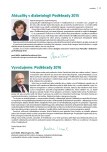Victoza changes diabetes and lives of patients 5 years already
Authors:
Jana Jiráčková 1,2; Alena Šmahelová 1
Authors‘ workplace:
III. interní gerontometabolická klinika LF UK a FN Hradec Králové
1; Ústav klinické biochemie a diagnostiky LF UK a FN Hradec Králové
2
Published in:
Vnitř Lék 2016; 62(3): 195-197
Category:
Reviews
Overview
Victoza (liraglutide) is a modern antidiabetic drug of GLP1 (glucagone like peptide) analogue group; since 2009 registered in Czech republic. VICTOZA is used in therapy of type 2 diabetic patients with preserved endougenous insulin secretion, usually in combination with other peroral antidiabetic drugs or with basal insulin. VICTOZA is applied once a day subcutaneously. The characteristical antidiabetic effect with β cell protection is enhanced with supportive weigth reduction effect. Positive cardiovascular influence is expected, however data from recent studies are not available at this time. In clinical practice, the mild upper dyspepsia after initiation of therapy is the most common side effect, usually subsiding in several days. Alltogether, VICTOZA is a well tolerated antidiabetic medication decreasing glycated hemoglobin up to 15 mmol/l with minimal risk of hypoglycaemia.
Key words:
diabetes mellitus type 2 – GLP1 analogue – incretine – liraglutide – Victoza
Sources
1. Holst JJ. The Physiology of Glucagon-like Peptide 1. Physiol Rev 2007; 87(4): 1409–1439.
2. SPC Victoza. Dostupné z WWW: http://www.sukl.cz/modules/medication/detail.php?code=0149309&tab=texts.
3. Marre M, Shaw J, Brandle M et al. Liraglutide, a once daily human GLP-1 analogue, added to aulphonylurea over 26 weeks produces greater improvements in glycaemic and weight control compared with adding rosiglitazone or placebo in subjects with type 2 diabetes (LEAD-1 SU). Diabet Med 2009; 26(3):268–278.
4. Nauck M, Frid A, Hermansen K et al. Efficacy and safety comparison of liraglutide, glimepiride and placebo all in combination with metformin in type 2 diabetes: the LEAD-2study. Diabetes Care 2009; 32(1): 84–90.
5. Garber A, Henry R, Ratner R et al. Liraglutide versus glimepiride monotherapy for type 2 diabetes (LEAD-3 Mono): a randomised 52-week, phase III double-blind, parallel treatment trial. Lancet 2009; 37(9662): 473–481.
6. Zinman B, Gerich J, Buse JB et al. Efficacy and safety of the humen glucagon-like peptide-1 analog liraglutide in combination with metformin and thiazolidindione in patients with type 2 diabetes (LEAD-4 Met + TZD). Diabetes Care 2009; 32(7): 1224–1230. Erratum in Diabetes Care 2010; 33(3): 692.
7. Russel JD, Vaag A, Schmitz O et al. Liraglutide vs insulin glargine and placebo in combination with metformin and sulfonylurea therapy in type 2 diabetes mellitus (LEAD-5 met + SU): a randomised controlled trial. Diabetologia 2009; 52(10): 2046–2055.
8. Buse JB, Rosenstock J, Sesti G et al. Liraglutide once a day versus exenatide twice a day for type 2 diabetes: a 26-week randomised parallel-group, multinational, for type 2 diabetes: a 26-week randomised, parallel. Group, multinational, open. Label trial (LEAD-6). Lancet 2009; 374(9683): 39–47.
9. Drucker DJ, Sherman SI, Gorelick FS et al. Incretin-based therapies for the treatment of type 2 diabetes: evaluation of the risks and benefits. Diabetes Care 2010; 33(2): 428–433.
10. Butler PC, Dry S, Elashoff R. GLP-1 based therapy for diabetes: what you do not know can hurt you. Diabetes Care 2010; 33(2): 453–455.
11. Butler PC, Matveyenko AV, Dry S et al. Glucagon-like peptide-1 therapy and the exocrine pancreas: innocent bystander or friendly fire? Diabetologia 2010; 53(1): 1–6.
12. Thomsen RW, Pedersen L, Moller N et al. Incretin-Based Therapy and Risk of Acute Pancreatitis: A Nationwide Population-Based Case-Control Study. Diabetes Care 2015; 38(6): 1089–1098.
13. Jung MJ, Kwon SK. Expression of glucagon-like peptide-1 receptor in papillary thyroid carcinoma and its clinicopathologic significance. Endocrinol Metab (Seoul) 2014; 29(4): 536–544.
14. Gier B, Butler PC, Lai CK et al. Glucagon like peptide-1 receptor expression in the human thyroid gland. J Clin Endocrinol Metab 2012; 97(1): 121–131.
15. Sun F, Yu K, Wu S et al. Cardiovascular safety and glycemic control of glucagon-like peptide-1 receptor agonists for type 2 diabetes mellitus: a pairwise and network meta-analysis. Diabetes Res Clin Pract 2012; 98(3): 386–395.
Labels
Diabetology Endocrinology Internal medicineArticle was published in
Internal Medicine

2016 Issue 3
Most read in this issue
- Victoza changes diabetes and lives of patients 5 years already
- Diabetes mellitus and pancreas cancer
- Motor vehicle driving and diabetes mellitus – medical aspects
- Obesity paradoxes
